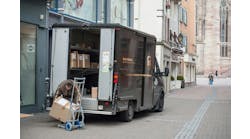The discussion I was tuned in to was a debate of whether to use shipping cartons as billboards, essentially advertising the virtues of the product inside, or stick with plain desert tan and hope evildoers think it contains kumquats, not computer components.
I was thinking that security, unlike beauty, must be more than skin deep. Security's more like ugliness; it goes clear to the bone. Since the elevator had stopped at my floor and everyone was glaring, waiting for me to exit, I never heard the end of the conversation I was acting like I did not hear. Obviously, I'd have to launch my own investigation.
Transport packaging professionals can do much to assure the products their companies manufacture reach the customer unscathed. That's what the job is, and always has been about—protecting the product.
Security and protection are not the same. Often, when the subject of product security is brought up, the images that enter people's minds are bulletproof containers, chains and locks, or vicious dogs. On a recent visit to the L.L. Bean store in Freeport, Maine, I learned that the opposite can be true. I watched as a store clerk put some snappy new sweaters onto a shelf. She was unloading them from a wire container that sported casters. The container moved easily on the store's woodplank floors and gave a clean look to moving merchandise from a distribution center to a shopper's hands.
Since this was an obvious material handling situation I was compelled to discuss the process with the retail representative. (My wife hates to go shopping with me if there's any chance the store will be using returnable containers or RFID tags.) Wire containers are used because they're lightweight and roll easily from the distribution center into trucks for the short trip to the retail store. The employee said the wire containers were reusable and they improve security. They are difficult to get into (when locked) and the inventory is highly visible. Managers can see what is there and what might be missing.
On another level, security means not having a brand stolen or a product counterfeited. Again, the first line of defense can be packaging. Rock-Tenn Company (Norcross, Ga.) has several lines of paperboard packaging products that take defying brand theft to a new level. Its most recent offering is a penreactive paperboard product. When marked with a special pen, an encapsulated coating on the paper stock—virtually impossible to duplicate—reacts with ink, temporarily changing color. After a few moments the ink disappears retaining the visual esthetics of the packaging. The box becomes a covert security device. Visual confirmation of authenticity of cartons entering the warehouse is immediate and as easy as the touch of the special pen.
This company has a few other ways to secure the product and foil the bad guys. It can insert ultraviolet fibers in the paperboard, or add "covert taggants," chemical markers used in inks or toners to distinguish originals from copies. Covert taggants are not readily observable. Special sensing systems are required that, in conjunction with the illumination source and sophisticated algorithms, detect the presence of the taggants.
These microscopic ultraviolet taggants, embedded at the mill, make instant authentication possible. Implanted machine-readable codes can enhance the security with database links and integration into a comprehensive security program. Encoded taggants can provide unique batch-code information leaving a clear trail to follow if tracing a product.
Bob Muscat, Rock-Tenn's director of marketing says, "Using this carton stock itself as a security device is not only straight forward, it allows brand owners to stay one step ahead of counterfeiters." And in keeping with the security theme, the manufacture of these products is so sensitive Muscat won't even say where the paperboard stock is manufactured. At a secure, undisclosed location is the best he offers.
General Douglas MacArthur said, "There is no security on this earth; there is only opportunity." If we remove opportunities for evildoers from the shipping equation, we could worry less about security and get on with business.


